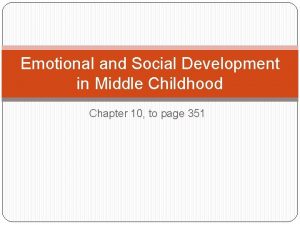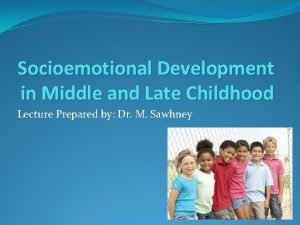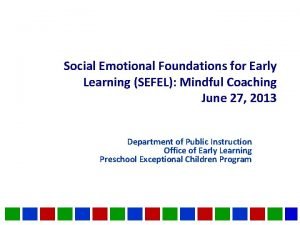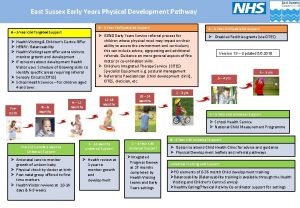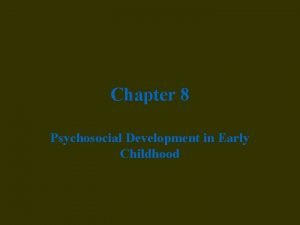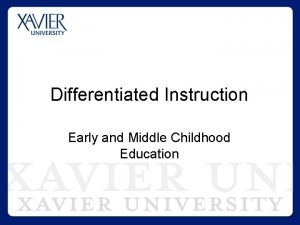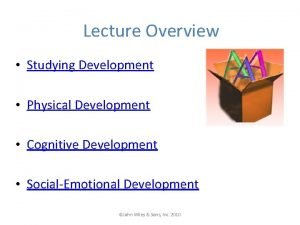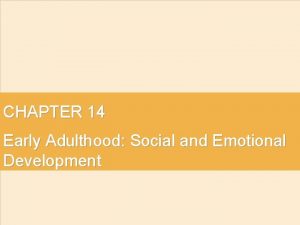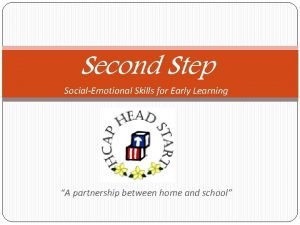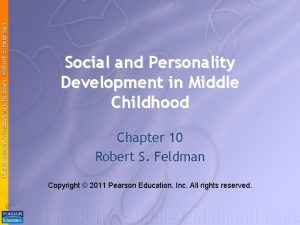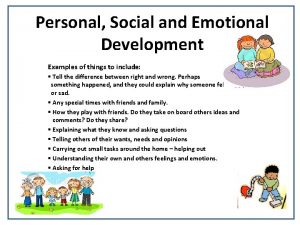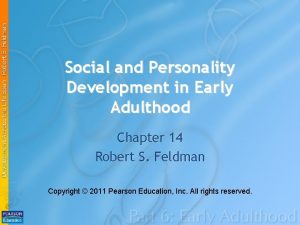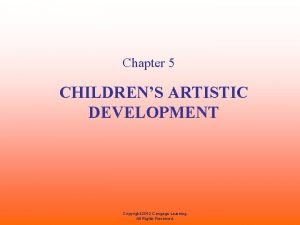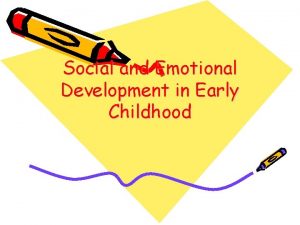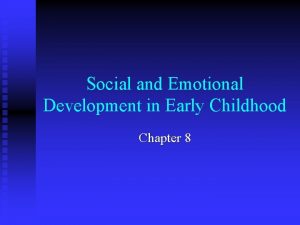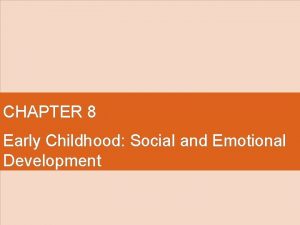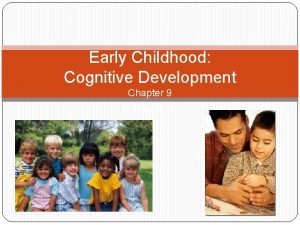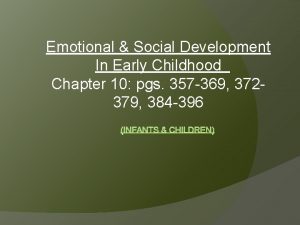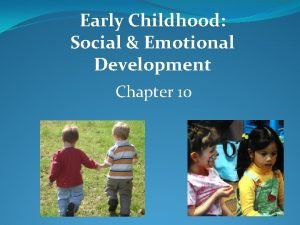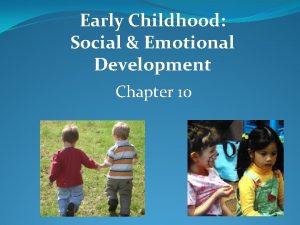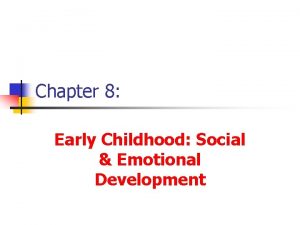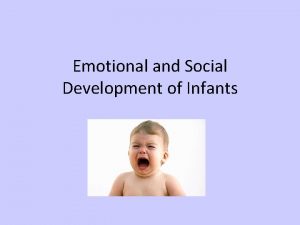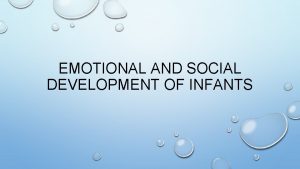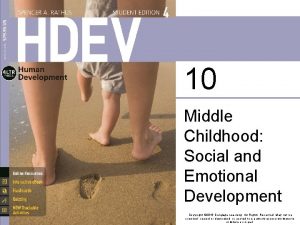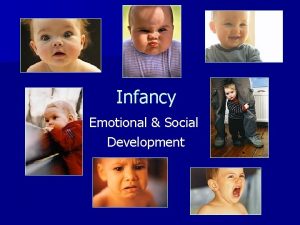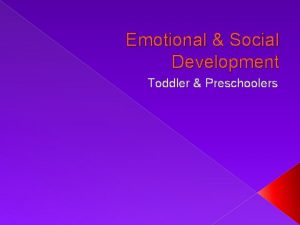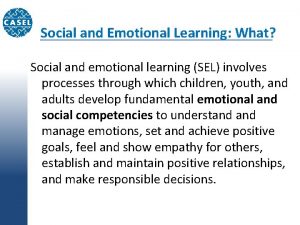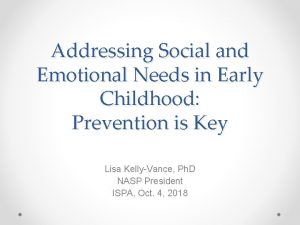8 Early Childhood Social and Emotional Development Copyright








































- Slides: 40

8 Early Childhood: Social and Emotional Development Copyright © 2016 Cengage Learning. All Rights Reserved. May not be scanned, copied or duplicated, or posted to a publicly accessible website, in whole or in part.

Dimensions of Child Rearing Copyright © 2016 Cengage Learning. All Rights Reserved. May not be scanned, copied or duplicated, or posted to a publicly accessible website, in whole or in part. HDEV 4 | CH 8 2

Table 8. 1 Baumrind’s Patterns of Parenting Copyright © 2016 Cengage Learning. All Rights Reserved. May not be scanned, copied or duplicated, or posted to a publicly accessible website, in whole or in part. HDEV 4 | CH 8 3

Parenting Styles: How Parents Transmit Values and Standards (continued 1) • Authoritative • Restrictive and demanding, yet communicative and warm • Display strong affection and respect children • Children are self-reliant and independent Copyright © 2016 Cengage Learning. All Rights Reserved. May not be scanned, copied or duplicated, or posted to a publicly accessible website, in whole or in part. HDEV 4 | CH 8 4

Parenting Styles: How Parents Transmit Values and Standards (continued 2) • Authoritarian • Value obedience with little explanation for their reasoning • Controlling and use of force • Do not communicate well with their children - Sons - Relatively hostile and defiant - Daughters - Low in independence and dominance Copyright © 2016 Cengage Learning. All Rights Reserved. May not be scanned, copied or duplicated, or posted to a publicly accessible website, in whole or in part. HDEV 4 | CH 8 5

Parenting Styles: How Parents Transmit Values and Standards (continued 3) • Permissive-indulgent • Low in their attempts to control their children and in their demands for mature behavior • Easygoing and unconventional • Permission accompanied by high warmth and support Copyright © 2016 Cengage Learning. All Rights Reserved. May not be scanned, copied or duplicated, or posted to a publicly accessible website, in whole or in part. HDEV 4 | CH 8 6

Parenting Styles: How Parents Transmit Values and Standards (continued 4) • Rejecting-neglecting • Parents are low in demands for mature behavior, control of children, and support and respsonsiveness • Children are least competent, responsible, and mature Copyright © 2016 Cengage Learning. All Rights Reserved. May not be scanned, copied or duplicated, or posted to a publicly accessible website, in whole or in part. HDEV 4 | CH 8 7

Additional types • Helicopter Parents • Bulldozer/Snowplow parents Copyright © 2016 Cengage Learning. All Rights Reserved. May not be scanned, copied or duplicated, or posted to a publicly accessible website, in whole or in part. HDEV 4 | CH 8 8

Social Behaviors Copyright © 2016 Cengage Learning. All Rights Reserved. May not be scanned, copied or duplicated, or posted to a publicly accessible website, in whole or in part. HDEV 4 | CH 8 9

Influence of Siblings • Children make advances in social skills and behavior during early childhood • Older siblings likely to be more caring and dominating than younger ones • Sibling rivalry contributes to: • Better social competence • Development of self-identity • Ability to rear their own children • Conflict increases when parents play favorites Copyright © 2016 Cengage Learning. All Rights Reserved. May not be scanned, copied or duplicated, or posted to a publicly accessible website, in whole or in part. HDEV 4 | CH 8 10

Adjusting to the Birth of a Sibling • Preschoolers may feel the stress due to the birth of a sibling and the changes within the family • Children show positive and negative reactions • Regression to baby-like behaviors • Independence and high level of maturity Copyright © 2016 Cengage Learning. All Rights Reserved. May not be scanned, copied or duplicated, or posted to a publicly accessible website, in whole or in part. HDEV 4 | CH 8 11

Adler and Birth Order • First-born children may be…. • Highly motivated to achieve than later-born children • Perform better academically, are more cooperative, more adult- oriented, and less aggressive than later-born children • Obtain higher standardized test scores • Show greater anxiety and are less self-reliant than later-born children Copyright © 2016 Cengage Learning. All Rights Reserved. May not be scanned, copied or duplicated, or posted to a publicly accessible website, in whole or in part. HDEV 4 | CH 8 12

Birth Order (continued 1) • Later-born children may be…. . • May compete for attention by acting aggressively • Self-concept is lower, but social skills translate into greater popularity with peers • Tend to be more rebellious, liberal, and agreeable than first born • Parents are more relaxed with later-born children Copyright © 2016 Cengage Learning. All Rights Reserved. May not be scanned, copied or duplicated, or posted to a publicly accessible website, in whole or in part. HDEV 4 | CH 8 13

Peer Relationships • Peer groups foster social skills • Teach how to lead and how to follow • Develop physical and cognitive skills through interactions • Provide emotional support • By age two, children show preference for particular peer • Notions of trust are developed only at an adolescent stage Copyright © 2016 Cengage Learning. All Rights Reserved. May not be scanned, copied or duplicated, or posted to a publicly accessible website, in whole or in part. HDEV 4 | CH 8 14

Play • Meaningful, voluntary, and internally motivated • Dramatic play: Children enact social roles • Contributes to social development of cognitive qualities - Curiosity, exploration, symbolic thinking, and problem solving Copyright © 2016 Cengage Learning. All Rights Reserved. May not be scanned, copied or duplicated, or posted to a publicly accessible website, in whole or in part. HDEV 4 | CH 8 15

Piaget’s Characteristics of Play • Functional play • Occurs during sensorimotor stage • Involves repetitive motor activity • Symbolic play • Occurs at end of sensorimotor stage • Involves creating settings and scripts Copyright © 2016 Cengage Learning. All Rights Reserved. May not be scanned, copied or duplicated, or posted to a publicly accessible website, in whole or in part. HDEV 4 | CH 8 16

Piaget’s Characteristics of Play (continued 1) • Constructive play • Child uses objects or materials to make something • Formal games • Games with rules may be invented by the child • Involves social interaction and physical activity with rules Copyright © 2016 Cengage Learning. All Rights Reserved. May not be scanned, copied or duplicated, or posted to a publicly accessible website, in whole or in part. HDEV 4 | CH 8 17

Parten’s Types of Play • Nonsocial play: Solitary forms of play • Occurs more in two to three year olds • Social play: Parallel play, associative play, and cooperative play • Common by age five • Girls more likely to engage in social play • Exception • Nonsocial play can include educational activities fostering cognitive development Copyright © 2016 Cengage Learning. All Rights Reserved. May not be scanned, copied or duplicated, or posted to a publicly accessible website, in whole or in part. HDEV 4 | CH 8 18

Gender Differences in Play • Boys • In preschool and early elementary school, boys often prefer vigorous physical activities • Girls • More likely to engage in arts and crafts and domestic play • Organized in a systematic way by adults • More likely to have an imaginary companion • More likely to stray from stereotypes Copyright © 2016 Cengage Learning. All Rights Reserved. May not be scanned, copied or duplicated, or posted to a publicly accessible website, in whole or in part. HDEV 4 | CH 8 19

Gender Differences in Play (continued 1) • Play choices determined by environmental influences and biological factors • Factors involved in the choice of the gender of the playmates • Boys often prefer play that is aggressive and rough • Boys often do not respond to girls’ polite requests • Boys often avoid girls because they see them as inferior Copyright © 2016 Cengage Learning. All Rights Reserved. May not be scanned, copied or duplicated, or posted to a publicly accessible website, in whole or in part. HDEV 4 | CH 8 20

Prosocial Behavior • Known as altruism • Intend to benefit another without expectation or reward • Empathy - Sensitivity to the feelings of others, connected with sharing and cooperation • Promotes prosocial behavior and decreases aggression • Girls more empathetic than boys Copyright © 2016 Cengage Learning. All Rights Reserved. May not be scanned, copied or duplicated, or posted to a publicly accessible website, in whole or in part. HDEV 4 | CH 8 21

Prosocial Behavior (continued 1) • Perspective taking • According to Piaget, children do not see other’s point of view • Children with better perspective taking ability show more prosocial behaviour • Influences on prosocial behaviour • Rewards and punishments • Inductive techniques Copyright © 2016 Cengage Learning. All Rights Reserved. May not be scanned, copied or duplicated, or posted to a publicly accessible website, in whole or in part. HDEV 4 | CH 8 22

Development of Aggression • Aggression - Behavior intending to hurt somebody • Preschoolers’ aggression is instrumental or possession oriented • By age six or seven, aggression is hostile and person oriented • Aggressive behavior may signify emotional and social problems in the future Copyright © 2016 Cengage Learning. All Rights Reserved. May not be scanned, copied or duplicated, or posted to a publicly accessible website, in whole or in part. HDEV 4 | CH 8 23

Theories of Aggression • Aggression results from a combination of biological and environmental factors • Genetic factors may be involved in aggressive behavior as well as criminal and antisocial behavior • MZ twins have high concordance rate for criminality • Child may become aggressive when provoked by the society in general Copyright © 2016 Cengage Learning. All Rights Reserved. May not be scanned, copied or duplicated, or posted to a publicly accessible website, in whole or in part. HDEV 4 | CH 8 24

Theories of Aggression (continued 1) • Aggressive children lack empathy and perspective taking • Physically aggressive parents may serve as models for aggression and also stoke their children’s anger • Reinforcement and observational learning may contribute to aggression • Children physically punished become aggressive Copyright © 2016 Cengage Learning. All Rights Reserved. May not be scanned, copied or duplicated, or posted to a publicly accessible website, in whole or in part. HDEV 4 | CH 8 25

Media Influences • Bandura’s Bobo doll study suggested that televised models influence children’s aggressive behavior • Children observing aggressive behavior behaved aggressively toward the doll themselves • Television - Fertile source of aggressive models • Media violence and violent video games contribute to aggressive behavior in children Copyright © 2016 Cengage Learning. All Rights Reserved. May not be scanned, copied or duplicated, or posted to a publicly accessible website, in whole or in part. HDEV 4 | CH 8 26

Figure 8. 1 Bandura’s Study of the Imitation of Aggression Copyright © 2016 Cengage Learning. All Rights Reserved. May not be scanned, copied or duplicated, or posted to a publicly accessible website, in whole or in part. HDEV 4 | CH 8 27

Personality and Emotional Development Copyright © 2016 Cengage Learning. All Rights Reserved. May not be scanned, copied or duplicated, or posted to a publicly accessible website, in whole or in part. HDEV 4 | CH 8 28

Personality and Emotional Development • Personality development becomes more complex as children age • Self-concept: One’s self-description and self -evaluation according to various categories • Such as child, adolescent, or adult, one’s gender, and one’s skills • Categorical self: Self-definitions that refer to concrete external traits Copyright © 2016 Cengage Learning. All Rights Reserved. May not be scanned, copied or duplicated, or posted to a publicly accessible website, in whole or in part. HDEV 4 | CH 8 29

Personality and Emotional Development (continued 1) • Self-esteem - Aspect of self-concept • Children with high self-esteem likely to be securely attached to their parents • Make evaluative judgments about their cognitive and physical competence as well as their social acceptance by peers and parents • Children become increasingly capable of self -regulation in early childhood • Due to maturation of brain Copyright © 2016 Cengage Learning. All Rights Reserved. May not be scanned, copied or duplicated, or posted to a publicly accessible website, in whole or in part. HDEV 4 | CH 8 30

Erikson’s Initiative versus Guilt • Children engage in learning new skills on their own • Strive to achieve independence from their parents and master adult behaviors • Fear of violating rules may cause the child to feel guilty • May curb efforts to master new skills Copyright © 2016 Cengage Learning. All Rights Reserved. May not be scanned, copied or duplicated, or posted to a publicly accessible website, in whole or in part. HDEV 4 | CH 8 31

Fears: The Horrors of Early Childhood • Number of fears peak between two and a half and four years old • Preschool period - Decrease in fears of loud noises, falling, sudden movement, and strangers • Middle childhood - Fears of failure and criticism in school and social relationships Copyright © 2016 Cengage Learning. All Rights Reserved. May not be scanned, copied or duplicated, or posted to a publicly accessible website, in whole or in part. HDEV 4 | CH 8 32

Development of Gender Roles and Gender Differences Copyright © 2016 Cengage Learning. All Rights Reserved. May not be scanned, copied or duplicated, or posted to a publicly accessible website, in whole or in part. HDEV 4 | CH 8 33

Development of Gender Roles and Gender Differences (continued 1) • Gender roles may be buried in stereotypes • Create demands and limit opportunities for both genders • Stages in gender roles • Children label gender by two and half years of age • Children traditionalize jobs, activities, and personality traits by the age of three and nine • Children perceive their own gender in a positive light Copyright © 2016 Cengage Learning. All Rights Reserved. May not be scanned, copied or duplicated, or posted to a publicly accessible website, in whole or in part. HDEV 4 | CH 8 34

Gender Differences • Males and females share a different anatomy • Differ in terms of behavior, personality characteristics, and abilities • Girls show somewhat greater verbal ability than boys, whereas boys show somewhat greater visual–spatial ability than girls but minimal • Preschoolers display differences in their choices of toys and play activities Copyright © 2016 Cengage Learning. All Rights Reserved. May not be scanned, copied or duplicated, or posted to a publicly accessible website, in whole or in part. HDEV 4 | CH 8 35

Organization of the Brain • Brain organization is genetically determined • May be female and male differentiated • Studies on rats and humans have indicated males and females rely on different parts of the brain when they are navigating • Females rely on the hippocampus in the right hemisphere along with the right prefrontal cortex • Males use the hippocampus in both hemispheres when they are navigating Copyright © 2016 Cengage Learning. All Rights Reserved. May not be scanned, copied or duplicated, or posted to a publicly accessible website, in whole or in part. HDEV 4 | CH 8 36

Cognitive-Developmental Theory • Kohlberg’s theory - Children form their perception about gender and then apply it to their behaviors Copyright © 2016 Cengage Learning. All Rights Reserved. May not be scanned, copied or duplicated, or posted to a publicly accessible website, in whole or in part. HDEV 4 | CH 8 37

Gender Identity • One's innermost concept of self as male, female, a blend of both or neither – how individuals perceive themselves and what they call themselves. One's gender identity can be the same or different from their sex assigned at birth. Copyright © 2016 Cengage Learning. All Rights Reserved. May not be scanned, copied or duplicated, or posted to a publicly accessible website, in whole or in part. HDEV 4 | CH 8 38

Gender expression • External appearance of one's gender identity, usually expressed through behavior, clothing, haircut or voice, and which may or may not conform to socially defined behaviors and characteristics typically associated with being either masculine or feminine. Copyright © 2016 Cengage Learning. All Rights Reserved. May not be scanned, copied or duplicated, or posted to a publicly accessible website, in whole or in part. HDEV 4 | CH 8 39

Transgender • An umbrella term for people whose gender identity and/or expression is different from cultural expectations based on the sex they were assigned at birth. • Often emerges age 2 -5 years of age • Being transgender does not imply any specific sexual orientation. Copyright © 2016 Cengage Learning. All Rights Reserved. May not be scanned, copied or duplicated, or posted to a publicly accessible website, in whole or in part. HDEV 4 | CH 8 40
 Middle childhood social and emotional development
Middle childhood social and emotional development Middle
Middle Socio-emotional development of late childhood
Socio-emotional development of late childhood Sefel training
Sefel training Fine motor skills development in early childhood
Fine motor skills development in early childhood Physical development in early childhood
Physical development in early childhood Psychosocial development in early childhood
Psychosocial development in early childhood Language development in early childhood
Language development in early childhood Early childhood is __________ for language learning
Early childhood is __________ for language learning Biosocial development in early childhood
Biosocial development in early childhood Early childhood development with differentiated instruction
Early childhood development with differentiated instruction Cognitive development in childhood
Cognitive development in childhood Physical development in adulthood
Physical development in adulthood Emotional development during early adulthood
Emotional development during early adulthood Second step social emotional skills for early learning
Second step social emotional skills for early learning Social development in infancy and childhood
Social development in infancy and childhood Personality development in middle childhood
Personality development in middle childhood Personal, social and emotional development examples
Personal, social and emotional development examples Social development for middle adulthood
Social development for middle adulthood Social and emotional development in late adulthood
Social and emotional development in late adulthood Social development in middle adulthood
Social development in middle adulthood Slidetodoc. com
Slidetodoc. com Personality development in early adulthood
Personality development in early adulthood Social emotional development erikson
Social emotional development erikson Professional development rockefeller college
Professional development rockefeller college Nsw department of education
Nsw department of education Crane center for early childhood research and policy
Crane center for early childhood research and policy Three types of early childhood programs
Three types of early childhood programs Chapter 2 types of early childhood programs
Chapter 2 types of early childhood programs Efq framework
Efq framework Early childhood framework for quality
Early childhood framework for quality How to welcome parents in orientation
How to welcome parents in orientation Leonardo da vinci childhood
Leonardo da vinci childhood Trends in early childhood education
Trends in early childhood education Early childhood research quarterly
Early childhood research quarterly Early childhood ireland garda vetting
Early childhood ireland garda vetting Chapter 7 early childhood ages 3 through 5 answer key
Chapter 7 early childhood ages 3 through 5 answer key Kellogg's stages of artistic development
Kellogg's stages of artistic development Amelia earhart facts about her childhood
Amelia earhart facts about her childhood Prosposed
Prosposed Pedagogical leadership in early childhood education
Pedagogical leadership in early childhood education
